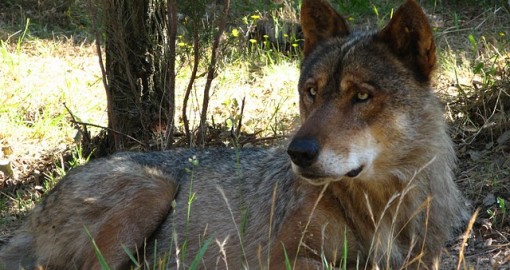Iberian wolf
Iberian Wolf ( Canis lupus signatus )
The Iberian wolf is a wolf population that inhabited the Iberian Peninsula. Due to the differences in morphology and behavior, he was described in 1907 by Ángel Cabrera Latorre as a separate subspecies (Canis lupus signatus ). Today, it is, however, a majority believe that the Iberian wolf subspecies belonging to the same as the Eurasian Wolf ( Canis lupus lupus ).
Features
The Iberian wolf is gray - brown in color and slightly narrower than the built Eurasian wolf. Characteristic are the black markings on forelegs and tail, and white coloration of the upper lip. Adult males reach a length of 120 to 140 cm and a weight of 30 to 40 kg and a shoulder height of up to 70 cm. The females are slightly smaller with 100 to 120 cm in length and a weight of 20 to 35 kg.
Another feature of the Iberian wolves, unlike other Eurasian wolves that they do not form larger herds, but in small family groups, usually consisting of parents with young animals of a year, live.
Nutrition
The largest part of the diet of wolves in Spain form, according to a study by the Spanish naturalist Félix Rodríguez de la Fuente, with about 35% of medium to large herbivorous mammals, such as Red and fallow deer, roe deer, chamois, ibex, wild boar or wild sheep. Second livestock, especially sheep, which account for about 24% already follow. Also the prey of Iberian wolves are hares, rabbits, voles, and to a lesser extent reptiles and birds. Occasionally, they also tear foxes or domestic dogs. In times when food is scarce the wolf also eats carrion and waste.
Dissemination
Historically
Until the 19th century, wolves were native to the Iberian Peninsula. However, in the 20th century, there was an active pursuit of the respected as pest animals, which led to a rapid decrease in population. In the early 1970s, the stock reached a low point, the habitat was restricted to the extreme north- west of the country, particularly along the Cantabrian Mountains, and a few packs in the Andalusian Sierra Morena.
Current
Strict protection measures resulted from the 1970s to the recovery of the wolf population, as well as an expansion of the distribution area. Live in the present 2000-2400 wolves in the Iberian peninsula, of which 1,500 to 2,000 in Spain and about 300 to 400 in Portugal, thus forming the Iberian wolves the largest and most stable component in Western Europe. The distribution area extends across much of north-western and central Spain and northern Portugal.
The largest population is found in the Sierra de la Culebra, Zamora Province. Other important areas are in the provinces of León, Palencia and Burgos, as well as in the Autonomous Communities of Asturias, Galicia and Cantabria. In Galicia there are even wolf packs in coastal areas (Sierra de Barbanza ), where they attack from and to the Broncos.
Smaller wolf populations can be found among others in Soria (Sierra de Urbión ), Valladolid, Segovia, La Rioja (Sierra de la Demanda ), Álava and Guadalajara (Sierra de Ayllón ). The population in the Sierra de San Pedro (Cáceres, Extremadura ) seems to be exterminated.
A small and acutely endangered population exists further still to the north of Andalusia, on the eastern Sierra Morena, in particular the Sierra de Andújar ( Jaén). Medium-term goal of conservationists to preserve the latter is a compound of the northwestern and southern habitat of the Iberian wolves.
Threats and conservation
The Iberian wolf is " Libro rojo de los vertebrados de España " in the classified (German: " Red List of Spanish Vertebrates " ) as vulnerable (endangered dt ). The "Atlas y Libro Rojo de Mamíferos terrestres de España " (engl.: "Atlas and Red List of land mammals of Spain " ) leads him into the category NT ( Near Threatened; German: Near Threatened ).
In Spain, the wolf is north of the Duero, where the population is considered stable, legally hunted with the exception of the Autonomous Community of Asturias. South of the Duero and in Portugal he is under strict protection. Poaching and the use of poison baits is, however, up to now, particularly for acutely endangered southern populations, represents a problem for the stock










